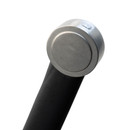According to Ewart Oakeshott. "Records of the Medieval Sword", page 151;
An identical one is shown on two early 14th century effigies in Germany. (i), of Arnold I Langraph of Cleve, + 1320 in Stiftskirche at Cleve, and (ii), of one of the hero-figures, c. 1308, in the Rathaus at Cologne. Not only are the hilts of the swords on these figures exactly the same as this sword, but the size is too, more proof (if any more is needed, which it shouldn't be) that these short swords were not made for boys, archers, etc., but for knights and in this case, great nobles.
The blade of this sword is hand forged from 5160 carbon steel and hand tempered. The blade is then securely peened at pommel. The handle is wood wrapped in black leather. Sword also includes a wood scabbard wrapped in black leather with steel accents at throat and tip.d them into giving false confessions before being burned at the stake. In 1312, Pope Clement V, under continuing pressure from King Philip, disbanded the Order. The abrupt disappearance of a major part of the European infrastructure gave rise to speculation and legends, which have kept the "Templar" name alive until the present.


 Gift Cards
Gift Cards



